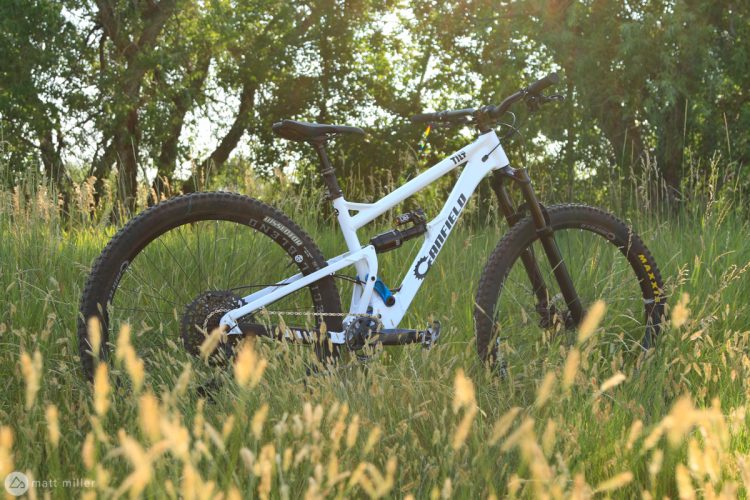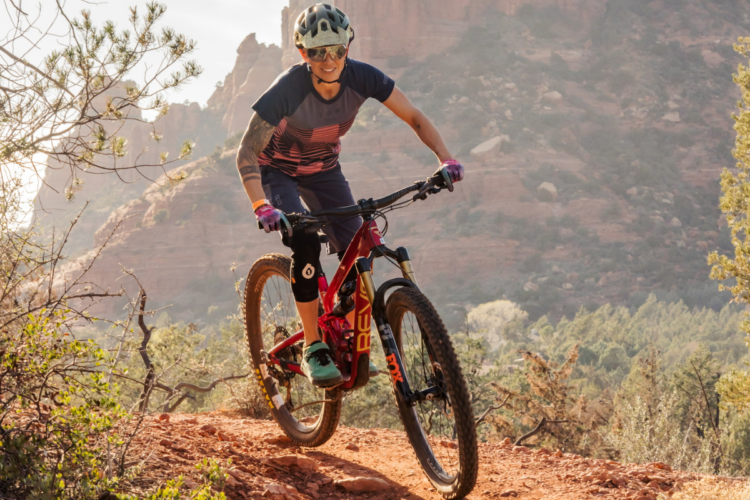
There are a lot of reasons to pick a bike with a big brand name: reputation, R&D, brand recognition, dealer support and so on. A lot of riders take those factors into account and it’s apparent which bikes are the hottest of the year when you start to see so many of them on the trail.
If you happen to live near Colorado’s Front Range, you’ll see a lot of the same names out there: Yeti, Guerrilla Gravity, Santa Cruz, Pivot, and so on. A lot of locals in any MTB locale will choose a regional brand if they can, but even for being a semi-local brand, you won’t spot many Canfields on the trail here compared to other brands.
And a lot of the folks who gravitate toward the above brands likely don’t recognize the Canfield name, despite their rich history in the sport, prized suspension design, and stout aluminum bikes. Those reasons alone make a bike more magnetic, at least to me.
There’s no shortage of full carbon shred sleds, with stretched out geometry and frame features in the market. But the Canfield Lithium, with travel to match, is distinct.

About the Canfield Lithium
- Price: $5,800
- Buy from Canfield and Worldwide Cyclery.
Canfield released the Lithium with their revamped bikes back in 2021. That summer we had the chance to check out the mid-travel Canfield Tilt and loved the bike. In many ways, the Lithium is a big Tilt, and the Tilt a small Lithium.
The Lithium has 163mm of rear travel, though with a shorter stroke shock it can be reduced to 151mm. The bike has 29-inch wheels front and rear and that rear wheel is controlled by the Canfield Balance Formula (CBF) suspension platform. The bike is paired with a 170mm fork. The rear suspension will work with either air or coil shocks.
Canfield says that an updated leverage curve gives the bike more beginning and mid-stroke support for a better pedaling bike, and more progression in the end of the stroke. Chain growth was reduced for less pedal kickback deep in the suspension and anti-rise values are lower for better braking and geometry at speed.
On the 7075 T6 alloy frame, the Lithium gets a one-piece upper link and a stiff rear triangle with one-piece forged stays for stiffness and durability. A brace joins both seat stays for increased lateral stiffness, similarly to the forged clamshell bottom bracket. Unfortunately the Lithium only has bottle mounts under the down tube, rather than inside the frame.

Geometry
For a big-travel bike that has been around for two years now, I have a hard time saying the Lithium is behind the curve, though it’s certainly not as progressive as other bikes in the category right now. At the time it was released, it seems Canfield could have pushed the numbers farther, however it wouldn’t necessarily make the bike better; just different.
On a medium Lithium, we get a 601mm effective top tube length and 450mm of reach, with 25mm of difference up or down sizes. The stack height is quite high at 640mm and standover height is average at 739mm.
The HTA is 64.5° and the effective STA is 76.7°. Seat tube lengths are short enough to fit long droppers. A size medium’s wheelbase is 1,221mm. To contrast this with the previous long travel bike I regularly rode, a Privateer 161, the Lithium is over an inch shorter.
Chainstays across sizes on the Lithium are a compact 430mm. The bike comes in four sizes: S-XL.
Climbing on the Lithium
I received this bike back in March and have been riding it throughout Colorado and neighboring states. In full transparency, I bought the bike and built it up from just a frame and shock using other review components that I had around at the time or have come my way since.
My only snag when I assembled the bike was finding out that the latest RockShox air shock I ordered with the bike would not actually fit the frame–just size large and XL frames. I swapped the shock for a RockShox coil, initially upset that I’d be adding weight to the bike, but the coil quickly grew on me, especially gnawing up the loose and technical climbs attached to the technical descents a bike like the Lithium finds itself on.
Coming from a heavy, aluminum enduro bike, I knew the Canfield wouldn’t be much different. At 35lb without pedals, you can’t expect a bike to gallop uphill. The Lithium is happy to grind with the rider planted on the saddle, but it grinds with a smile on its face. As I’ve experienced with the Tilt, and Revel’s CBF bikes, there is a certain magic to the suspension platform where the bike sort of glides when you’re pedaling. This aluminum enduro bike carries its weight well.
While the added weight of a coil was a concern of mine at the beginning, the added traction washed my worries away. It’s entertaining how good traction is with this bike and a coil shock. Fitness must account for my climbing shortfalls on the Lithium, because the bike is happy to claw its way up just about everything.
The one area that could be improved is the seat tube angle. At under 77° for the medium, it’s not as competitive with other models on the market, but most of the time I got along with it. On steeper sections though, I scooted forward and warmed the nose of my saddle. Canfield describes the Lithium as a versatile bike, and the geometry aids this, making the bike more suitable to non-enduro terrain. Seat tube angles can be too steep and put the rider’s weight too far into the cockpit. The Lithium doesn’t have this problem, but I would have loved it if it were a half-degree steeper.
In most cases though, the moderate STA and the high stack height of the bike gives it a pleasant feel in the cockpit. It’s roomy and comfortable. The shorter wheelbase also helps the rider with tricky up-and-overs.

Descending with the Canfield Lithium
With the postured stance of the Lithium, coil shock and big fork, it’s easy to tell what the bike wants to do. After working through all the potential suspension settings — spring rates, rebound, air pressure, etc. — I’ve found the Lithium’s happy place in the past few weeks.
You can call the Lithium a long travel trail bike or an enduro bike with conservative geometry. Either way, I’ve been happy with the bike’s personality.
The handling is quick and agile and the Lithium snakes through tight and fast sections with ease. I’d credit the maneuverability to the shorter wheelbase, a moderate reach, and sharp chainstays.
Geometry like this is why I feel like there are two camps when it comes to long-travel bikes: the long, racy horses that keep you stable and smooth between two stretched out wheels on any kind of course, and the plush surfboards which let the rider cut, carve and play. Those short stays on the Lithium let the rider yank up to manual over rollers and swipe the rear tire around switchbacks.
Canfield does a good job of describing the bike’s suspension characteristics. The Lithium is stable and planted, soaking up chunder, but it’s not as deep or plush as something like the Santa Cruz Megatower. There’s a lot of support to make the most of bump jumps, tabletops, and drops and I have yet to feel like the bike has lost its bearing.

The CBF lets the rear wheel get out of the way so the bike can pick up speed over chunky, square-edged rocks. I haven’t felt any strong signs of pedal kickback either. The Lithium does an admirable job at keeping the bike’s stress separated from your feet.
One area where it’s not the most comfortable is on steep, pitched terrain. I’ve felt a little high on the bike and sat on the rear wheel a few times negotiating tall rock gardens and lines, but to be honest, that is a problem common with many 29ers.
The lack of cable management devices also makes itself known on the descents. There is a noticeable clacking of cables inside the frame. The bike is internally routed but the cables are not under any restraint inside the tubing.


Components and build options
As a complete build, the Lithium comes in one build for $5,800, but Canfield does allow swapping out some components a la carte style.
Said build includes a DVO Topaz air shock, MRP fork, E*Thirteen wheels, TRP Slate T4 brakes and TR12 drivetrain with 165mm SRAM cranks. All of these components are upgradable, but the price can add up quickly. They all seem like apt components for the Lithium, but I’d likely upgrade the Slate brakes if I were ordering a complete.
Buyers can also get a frameset with a fork for roughly $3,100 or do just a frame and shock for $2,300 and up.
I’ve been riding the Lithium with a RockShox SuperDeluxe RC2T Coil and Fox 38, Hope Tech E4 brakes and Hope carbon handlebars, a Shimano 12-speed drivetrain, and Maxxis tires. Look for reviews on the Wolf Tooth Resolve dropper post and Reserve 30 SL/AL wheels soon.

Pros and cons of the Canfield Lithium
Pros
- Versatile geometry
- Stands out among common enduro bikes
- Great suspension characteristics uphill and downhill
- Playful for a big bike; easy to get up and over obstacles and whip around
Cons
- Some may not find it aggressive enough (but not the only bike in this camp)
- Build options might not be for everyone
- Cable rattle noise
- STA could be steeper
Closing thoughts
Over the past few years, there seem to be two camps for long-travel bikes: The nimble, versatile ~160mm bikes that are ready to pedal anything and the long-limbed sleds racers will gravitate toward. The Canfield Lithium is the former, with measured geometry, stability for speed, and a playful personality.
- Price: $5,800
- Buy from Worldwide Cyclery.



















